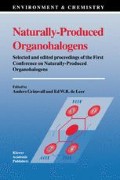Abstract
The presence of halogenated organic compounds in groundwaters was long considered to be a proof of anthropogenic pollution. The widespread occurrence of chlorinated solvents was well established (e.g. Westrick, Mello and Thomas, 1984; Veenendaal, Beek and Puijker, 1986), and chlorophenols (e.g. Kenrick et al., 1985) and chlorinated pesticides (e.g. Spalding, Burback and Exner, 1989) had been found in groundwaters. Some of the most prevalent haloorganic contaminants in groundwaters not affected by point sources are listed in table 1. However, it is important to point out that this selection of compounds can be biased; with a few exceptions (e.g. Page, 1981; Kenrick et al., 1985; Veenendaal, Beek and van Puijker, 1986) groundwater monitoring of organic contaminants have been restricted to one or a few classes of contaminants. When point sources play an important role, the number of contaminants and their concentrations can be much larger.
Access this chapter
Tax calculation will be finalised at checkout
Purchases are for personal use only
Preview
Unable to display preview. Download preview PDF.
References
Asplund, G., Grimvall, A. and C. Petterson, 1989. Naturally produced adsorbable organic halogens (AOX) in humic substances from soil and water. Sci. Tot. Environ. 81/82, 239–248.
Grøn, C., 1990. Organic halogen group parameters in groundwater investigations. Chemosphere 21, 135–152.
Grøn, C., 1991. Organic halogens in Danish groundwaters. Lecture Notes in Earth Sciences 33, 495–506.
Grøn, C., 1993. Organic halogen group parameters as indicators of ground water contamination. Ground Water Monitoring and Remediation 13 (3), 148–158.
Grøn, C. and B. Raben-Lange, 1992. Isolation and characterization of a haloorganic soil humic acid. Sci. Tot. Environ. 118, 281–286.
Harper, D.B., 1985. Halomethane from halide ion -A highly efficient fungal conversion of environmental significance. Nature 513, 55–57.
Hendry, M.J., McReady, R.G.L. and W.D. Gould, 1984. Distribution, source and evolution of nitrate in a glacial till of Southern Alberta, Canada. J. Hydrology 70, 177–198.
Hoekstra, E. and E.W.B. de Leer, 1993. The production of low-molecular-weight chlorinated compounds in soil top layers. Presented at the International Conference on Naturally Produced Organohalogens. Delft, 14–17 September, 1993.
Keller, C.K., van der Kamp, G. and J.A. Cherry, 1991. Hydrogeochemistry of a clayey till. 1. Spatial Variability. Water Resour. Res. 27, 2543–2554.
Kenrich, M.A.P., Clark, L., Baxter, K.M. Fleet, M., James, H.A., Gibson, T.M. and M.B. Tunnel, 1985. Trace organics in British aquifers -a baseline survey. Technical Report TR 223. Water Research Centre, Medmenham, England.
Kerndorff, H., Brill, V., Schleyer, R., Friesel, P. and Milde, G., 1985. Erfassung grundwassergefährdender Altablagerungen, WaBoLu Berichte 5.
Kool, H.J., C.F.van Kreijl and Oers, H.van, 1984. Mutagenic activity in drinking water in the Netherlands-A survey and a correlation study. Toxicol. Environ. Chem. 7, 111–129.
Lovelock, J.E., Maggs, R.J. and R.J. Wade, 1973. Halogenated hydrocarbons in and over the Atlantic. Nature 241, 194–196.
Page, G.W., 1981. Comparison of groundwater and surface water for patterns and levels of contamination by toxic substances. Environ. Sci. Technol. 15, 1475–1481.
Palmer, T.Y., 1976. Combustion sources of atmospheric chlorine. Nature 263, 44–46.
Peoples, S.A., Maddy, K.T., Cusick, W., Jackson, T., Cooper, C. and A.S. Frederickson, 1980. A study of samples of well water collected from selected areas in California to determine the presence of DBCP and certain other pesticide residues. Bull. Environ. Contam. Toxicol. 24, 6111–618.
Postma, D., Boesen, C., Kristiansen, H. and F. Larsen, 1991. Nitrate reduction in an unconfined sandy aquifer: Water chemistry, reduction processes, and geochemical modelling. Water Resour. Res. 27 (8), 2027–2045.
Sorrell, R.K., Daly, E., Boyer, L. and Brass, J., 1985. Monitoring for volatile organohalides using purgeable and total organic halide as surrogates. Proceedings of the Fifth Conference on Water Chlorination: Environmental Impact and Health Effects. Williamsburg, Virginia, June 3–8, 1984.
Spalding, R.F., M.E. Burbach and M.E. Exner, 1989. Pesticides in Nebraska’s ground water. Ground Water Monitoring Review 9, 126–133.
Stevens, A.A., Dressman, R.C., Sorrell, R.K. and Brass, H.J., 1985, Organic halogen measurements: current uses and future prospects. J. Am. Water Works Assoc. 77, 146–154.
Thiess, W.G., Sullivan, J.H., Adams, W.D., Steinberg, J.A. and Baker, R.D., 1985. Installation restoration program. Phase II. Confirmation/quantification stage. Tyndall Air Force Base, Florida. Report abstract.
Veenendaal, G., Beek, C.G.E.M. and van Puijker, M., 1986. Organische Stoffen in grondwater, KIWA mededeling No. 97.
Westrick, J.J., J.W. Mello and R.F. Thomas, 1984. The groundwater supply survey. J. Amer. Water Works Assoc. 76, 52–59.
Wever, R., 1991. Formation of halogenated gases by natural sources, in J.E. Rogers and W.B. Whitman, eds., Microbial production and consumption of greenhouse gases; Methane, nitrogen oxides, and halomethanes, American Society for Microbiology, Washington D.C., 1991.
Williams, D.T., Coburn, J.A., and Bancsi, J.J., 1984. Study of total organic halogen as a means to detect groundwater contamination. Environ. Internat. 10, 39–43.
Author information
Authors and Affiliations
Editor information
Editors and Affiliations
Rights and permissions
Copyright information
© 1995 Springer Science+Business Media Dordrecht
About this chapter
Cite this chapter
Grøn, C. (1995). AOX in groundwater. In: Grimvall, A., de Leer, E.W.B. (eds) Naturally-Produced Organohalogens. Environment & Chemistry, vol 1. Springer, Dordrecht. https://doi.org/10.1007/978-94-011-0061-8_4
Download citation
DOI: https://doi.org/10.1007/978-94-011-0061-8_4
Publisher Name: Springer, Dordrecht
Print ISBN: 978-94-010-4032-7
Online ISBN: 978-94-011-0061-8
eBook Packages: Springer Book Archive

